Archive Monthly Archives: May 2018

What if You Lose the Likeness From Your Sketch?
You have some time to paint over the weekend. You set up your reference photo, knock out a nice looking sketch, and then excitedly start to paint…
But something happens.
After a few layers, things start to unravel. Suddenly, it just doesn’t look like the person you’re trying to do a portrait of anymore. You paint some more in an attempt to restore what you lost in the sketch, and now you’ve only made it worse!
Frustration sets in.
Can I fix this painting? Or do I have to start over? How much time did I spend on this already?
I had exactly this question asked of me by a student…
I can get a good likeness with the sketch but I seem to lose lots of the likeness after a few layers of paint. What do you think happens? –Ron
My answer back to him will be the basis for this article today. I think it will benefit you as well, if you have lost your likeness after sketching. I know I have!
Here’s some tips to prevent the likeness in your sketch from being lost in your painting and also, how to get it back on track if you do.
1. Seal in Your Sketch
I know this sounds simple, but if you just start painting over pencil the thick paint on your brush will lift off some of the pigment on your canvas and it will smear. The end result is a muddy mix of paint and pigment and lost detail.
First of all, use colored pencil instead of graphite pencil to do your sketch. Burnt ochre or a similar color works best. Then carefully seal in the sketch with a wide synthetic bristle brush and matte medium.
Once it’s dry you will have a barrier between your sketch and your paint.
2. Paint Lightly at First
When you start your actual painting process, I recommend to use thin glazes of paint (tiny bits of paint mixed with generous portions of matte medium) and gently block in the color and value. You want to just barely see the change between the white canvas and the color you’re putting down at first.
Then, as you add more layers and depth, you can get aggressive with your paint. (At least compared to how you start out!) In the beginning, you’ll use a ratio of 90% medium to 10% paint and then later, closer to 50-50.
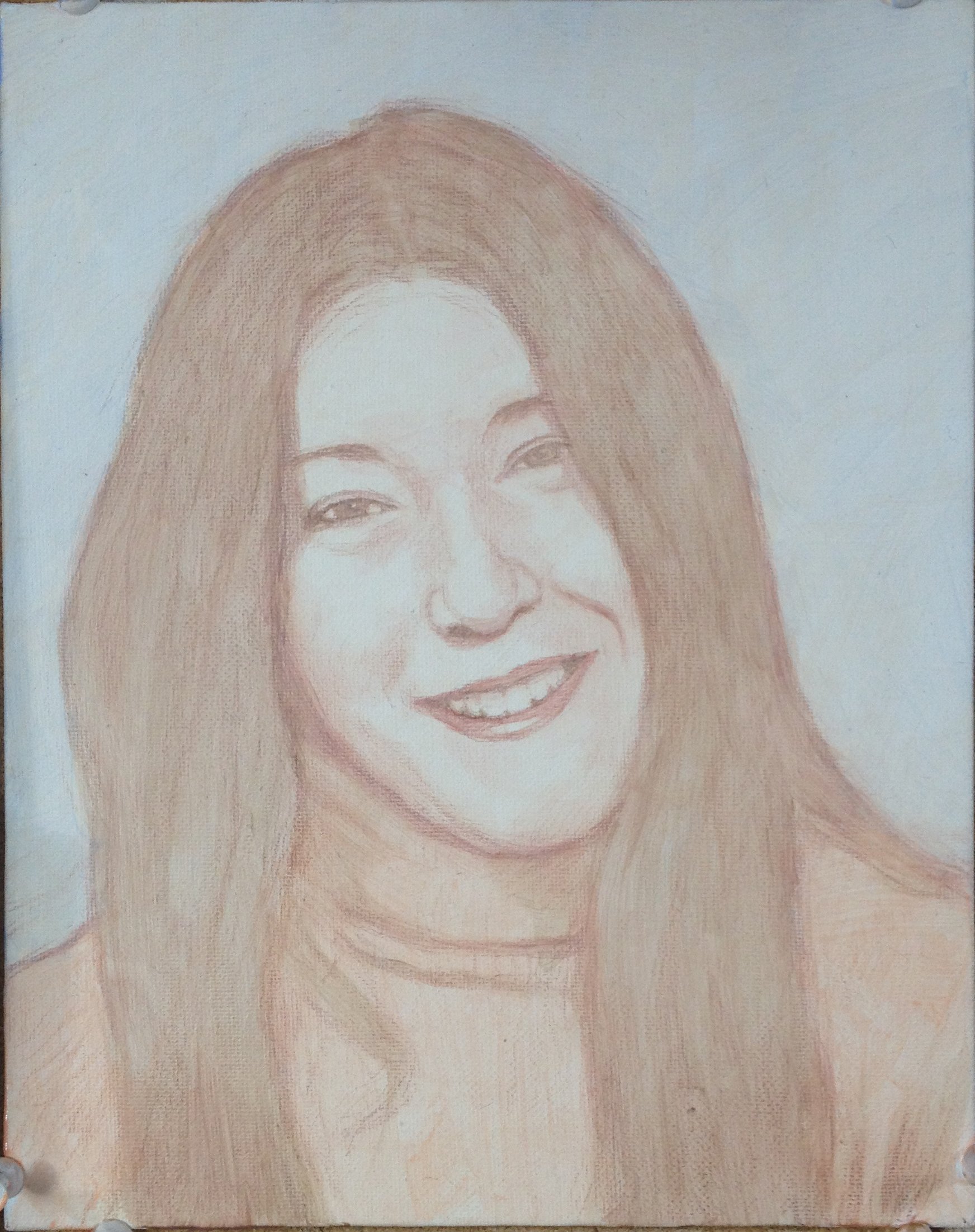
By going light, you will preserve the detail of your sketch beneath. Only toward the middle to the end of the painting process will the sketch get completely covered up.
3. Convert Pencil Lines to Paint

Paint over the details of your sketch intermittently with round brushes as you paint the large areas with your flat brush. It will be a constant push-and pull between blocking in large areas of value and color, and fussy detail work. Toward the end of the painting you will be favoring more of the detail aspect of your painting.
As you darken in some of these pencil lines, you’ll ensure you don’t lose that valuable detail that you laid out in the sketching stage while applying large layers.
If you’d like to learn more, sign up to receive my portrait painting tips via email. I’ll send you video lessons to show you how to paint a realistic portrait in acrylic step-by-step!
Get My Latest Acrylic Portrait Painting Tips!
4. Emphasize Value Over Line
Remember that it is shading and value–those differences between light and dark with all the subtle variations–that describe a three dimensional illusion on a two-dimensional surface.
Lines can’t do that.
Only shading can.
The lines in our sketch are there to tell us where to put the shading in during the painting process. And if you do some shading during the sketching process, even better. Then you’ll be able to just enhance those areas with paint.
It is the shading (the use of value) that tells us how large someone’s chin is, or the roundness of their nose, or fullness of their cheek, or boniness of their forehead.

So, my point is this: do some shading on your sketch, and that will help your painting process along.
5. You Will Lose the Likeness to Some Degree
That’s normal. Happens to me all the time when I paint. Knowing this ahead of time will clear your mind of unrealistic expectations so that your frustration level can go down…and you can paint to the best of your ability.
The reason that the likeness inevitably does get lost is that as you’re adding these various values in different places, there will be some spots on your painting that are just less finished than others. You may have painted the eyes about as dark as they are in the reference photo, but the eyebrows haven’t “caught up” yet.

Or maybe you added some deep shadows under the chin, but you haven’t quite dialed in the shading for the cheeks. If the person’s chubby cheeks are a main part of their features, then missing this aspect can really throw off the likeness.
And this can go for parts all over the face.
I am working on a painting right now of three children as I write this blog post, and the likenesses aren’t quite there yet. In fact, they look “off” to me. But I know that if I stick with it, it will work out. I prayed that God would help me to do it well, and I believe He will.
However, as in all of life, there’s a struggle we have to go through to get to the other side. You can’t have the mountains without the valleys. So, I’ll stick with this, keep looking at my reference photo, keep praying and putting paint on the canvas.
And the end result, by God’s grace, will be a fantastic painting that the client will love.
So for you, this means that as you bring all the unfinished areas of your portrait to completion, eventually, the likeness will not only get restored to how it was during your sketch, but it will be even better.
6. Get Critiques of Your Work
When you’ve tried the other tips and you feel like your painting is way off track you may want to consider getting a critique. If you have an artist group where you meet in person, that may be a good way to go. I have a Facebook group as well if you need some quick feedback. If you haven’t already, I invite you to join the group. The folks there are very helpful.
7. Start Over…If You Must

I don’t recommend starting over a painting, except as a last resort. I think it’s much better to stick with a painting and resolve problem areas to build confidence in your skills as an artist and to save time and money.
But if you find yourself sinking way too much time into the painting, reworking the same area over and over, and the texture is built up so much that you want to sand it off, it may be time to start over.
If the painting is in the beginning stages, and the composition or likeness was wrong from the start, then re-doing it may be the best choice. It may take less time to just start over than try to rectify your mistakes. You’ll have to look at your painting and ask yourself “how far off is it?” Sometimes we get hard on ourselves as artists (we’re perfectionists by nature) and it might be just a tiny thing that can make all the difference.
I had a painting like that. It just didn’t look like the guy. Then I added a reflection on his eye that took all of one minute to paint–and that did it. It was him!
So, get a second opinion with a good critique, and then you’ll know if it’s worth it to start over. The person critiquing your may be able to give you an idea of how far off the rails you are. You may be closer that you think!
And there you have it: 7 tips to help you how to not lose your likeness, or if you do, how to get it back. Let me know how this helps!
Blessings to you and your painting,

P.S. Did you find this post helpful or encouraging? If so, send it on ahead! Let others know with the share buttons below. I’d love to hear your comments. Thank you so much! Also, do you have a question on acrylic portrait painting you’d like answered? Let me know, and I’d be happy to help!
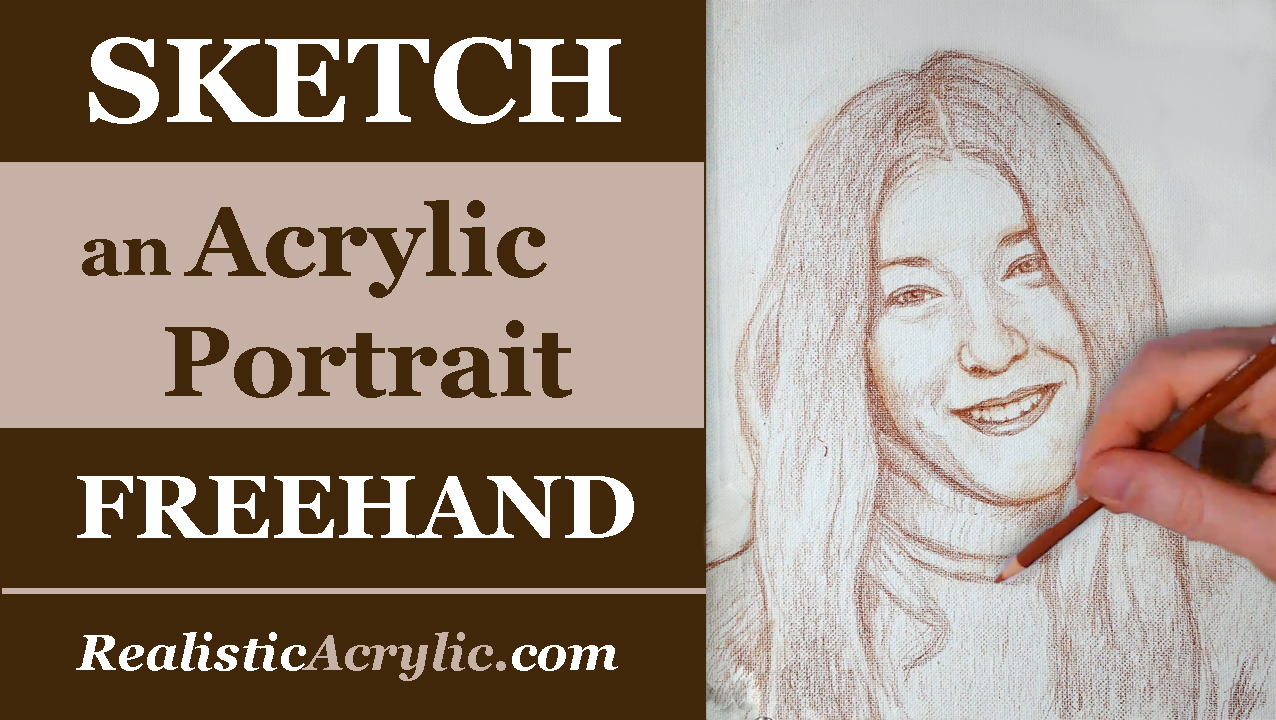
5 Steps to Sketch an Acrylic Portrait Freehand
Using a grid or tracing can be a great way for artists just starting out in portrait painting to create a lifelike, accurate sketch. It also can help experienced painters either save time or get their proportions a bit more accurate so they can concentrate more on their painting process.
But sometimes, it’s fun to just “throw off the training wheels” and do your sketch freehand. In fact, drawing freehand will enhance your ability to see intricate spacial relationships, shapes and contours that are vital at any stage in your painting.
You’ll learn to capture those small nuances that will make a person look like them.
What is the best way to draw freehand?
I’m not going to say I have the best method, but it has served me well in over 20 years of doing portrait art. I’d like to share that with you today, using this 8″ x 10″ commissioned portrait as an example…
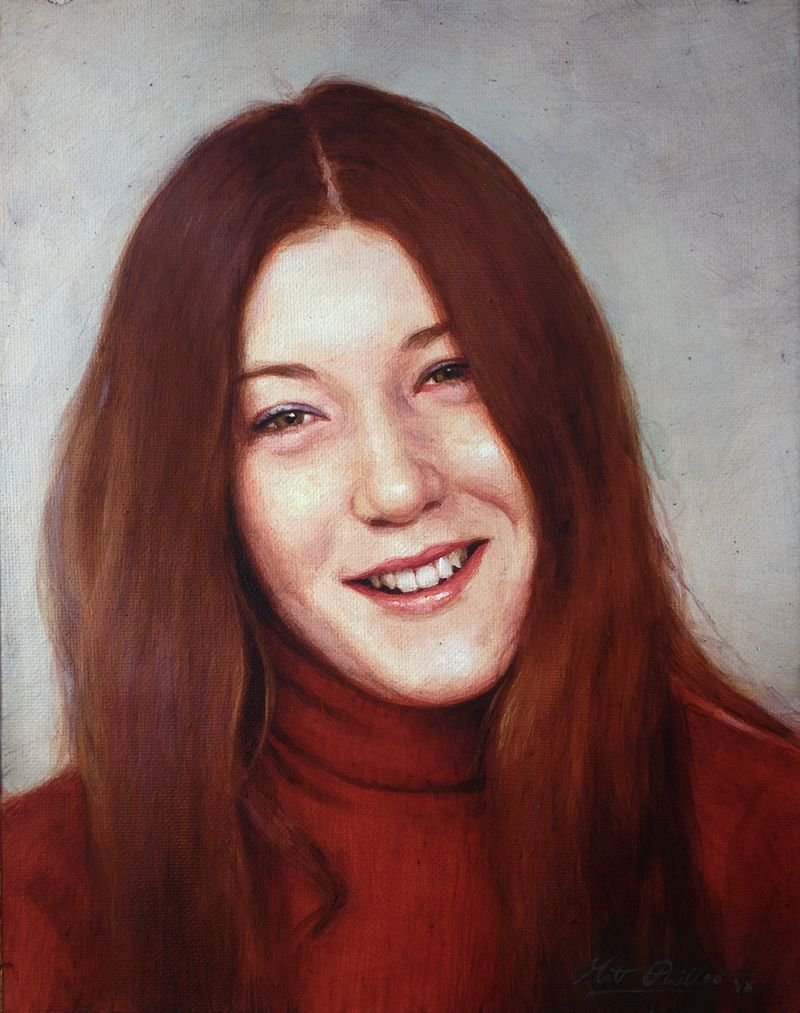
Tools needed:
Canvas
Burnt Ochre Prismacolor colored pencil
Electric pencil sharpener
White smooth eraser
Here is the 15-minute video tutorial. The drawing took almost an hour.
The rest of this tutorial–showing the entire process, from sketch to finished acrylic portrait painting (about 7 hours of video instruction)–will soon be available as an online class. You can get access to it, and several other pre-recorded painting courses by becoming a member of Realistic Acrylic Portrait School.
Join Realistic Acrylic Portrait School TodayStep 1: Locking in the Composition
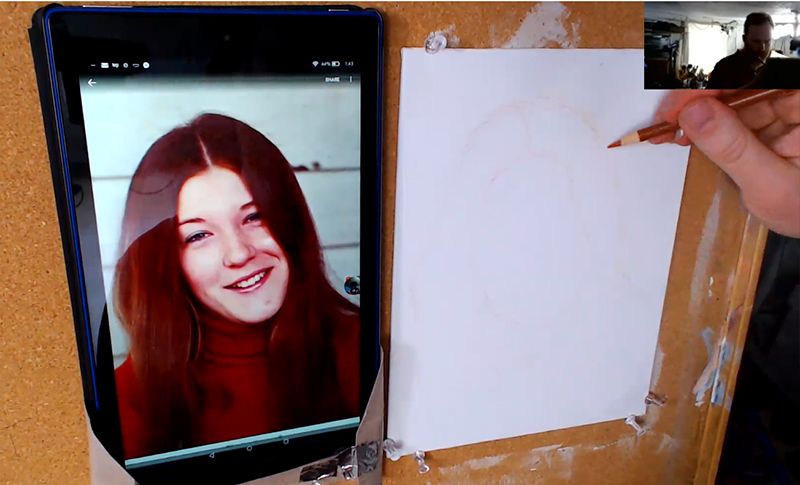
In this step, you want to plot out where your drawing is going. Here’s a few rules of thumb for a good composition and accurate initial proportions…
-Fill the image area as much as possible
-If you were to draw an imaginary line 1/3 of the way down from the top of the canvas edge, that line should go right through the middle of the face.
-Don’t let any major lines touch the edge of the “picture plane” (edges of the canvas)
-Look for the overall shape of the head: Is it oval? Long? Short and wide?
-Use light, short, choppy strokes to capture everything at first. It will be much easier to adjust and erase.
Step 2: Suggesting the Facial Features
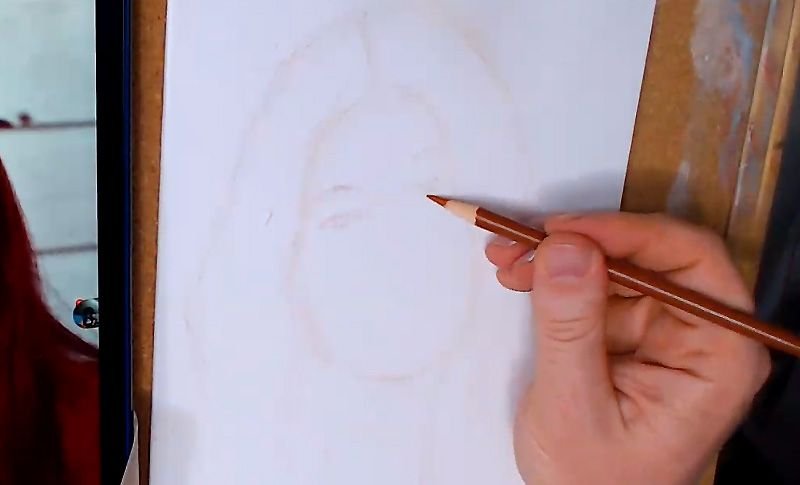
After plotting out your composition, you want to start filling in the facial features. It’s good to draw lightly at first. We just want to get the basic location on the face and the overall impression of what they look like.
Start with the eyes. The eyes (and eyebrows) are THE most important feature to capture correctly on a face.
Ask yourself…
-Where are they located in relationship to the top and bottom of the head? Usually eyes are right in the middle, but that can vary from person to person.
-Are they large or small?
-Are they close together or far apart? Usually eyes are about one-eye-width apart from each other.
-Are the eyebrows straight or curved? Angled up or down? Thin or thick?
-How much of a distance is there between the eyebrows and eyes?
-What’s the shape of the eyes? Narrow? Rounded? Angled?
-How much of the top eyelid is showing? Some people have prominent upper eyelids. With others you can hardly see it.
-Are the eyelashes thick or thin?
Now, these questions will come more into play later on as you refine the sketch, but for now at this stage, just get the general idea captured.
Next, you’ll move down to the nose. It’s important to see the distance between the eyes and the nose and draw that. The shape between the nose and eyes forms a triangle. If you can get a sense for that shape, it will really help you out. Is the triangle wide or long?
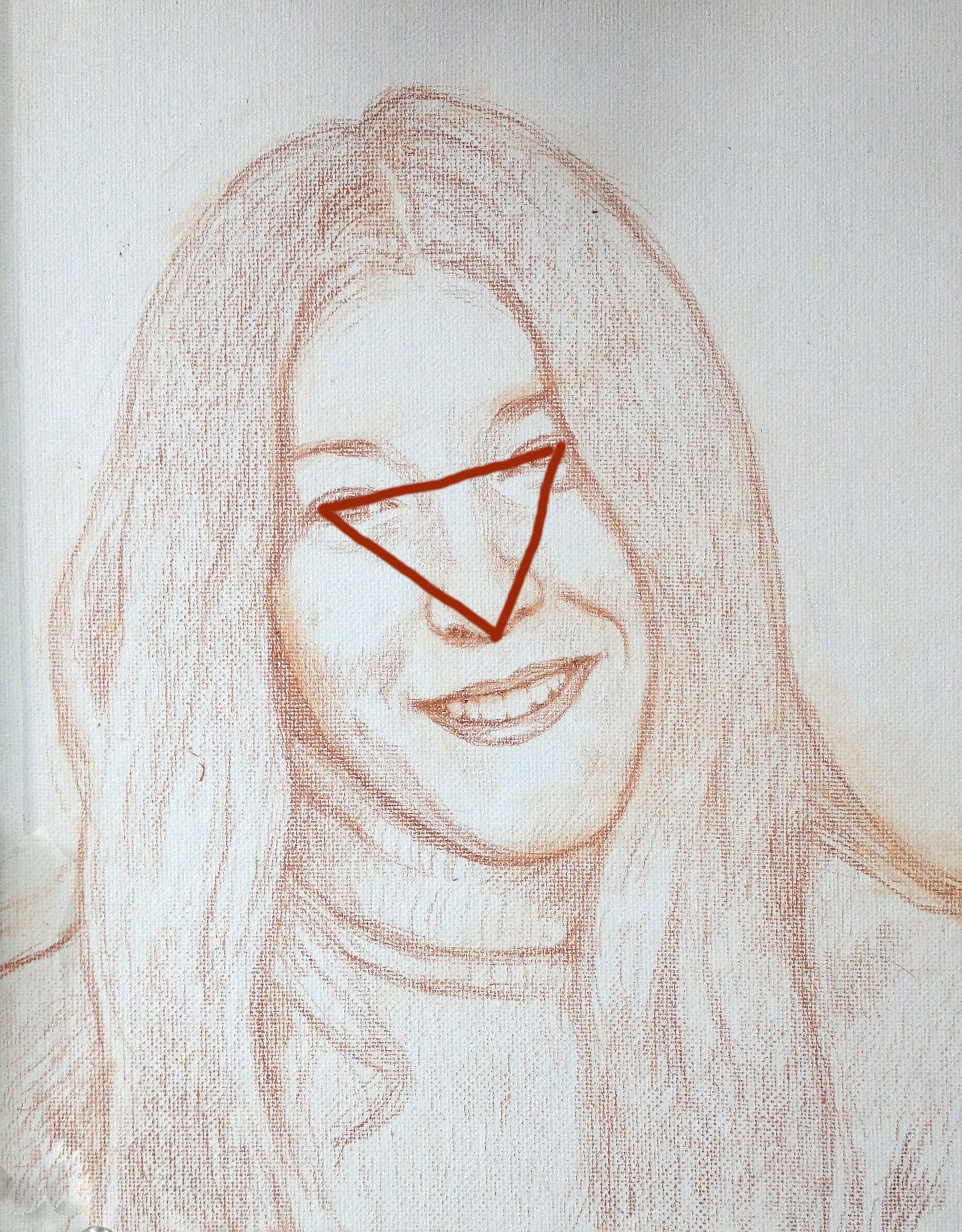
I am not saying to draw a triangle on your sketch. Just use the concept to see that spacial relationship between the eyes and the nose and draw it accurately.
Notice the particular shape of the nose and nostrils and draw it in. Are the nostrils prominent or obscured? Is the nose wide or skinny?
Then, move down to the mouth. You’ll want to just get the overall shape. Here’s some rules of thumb for drawing the mouth…
-The top lip is usually thinner than the bottom lip
-When smiling, the edges of the mouth usually line up with the middle of the eyes
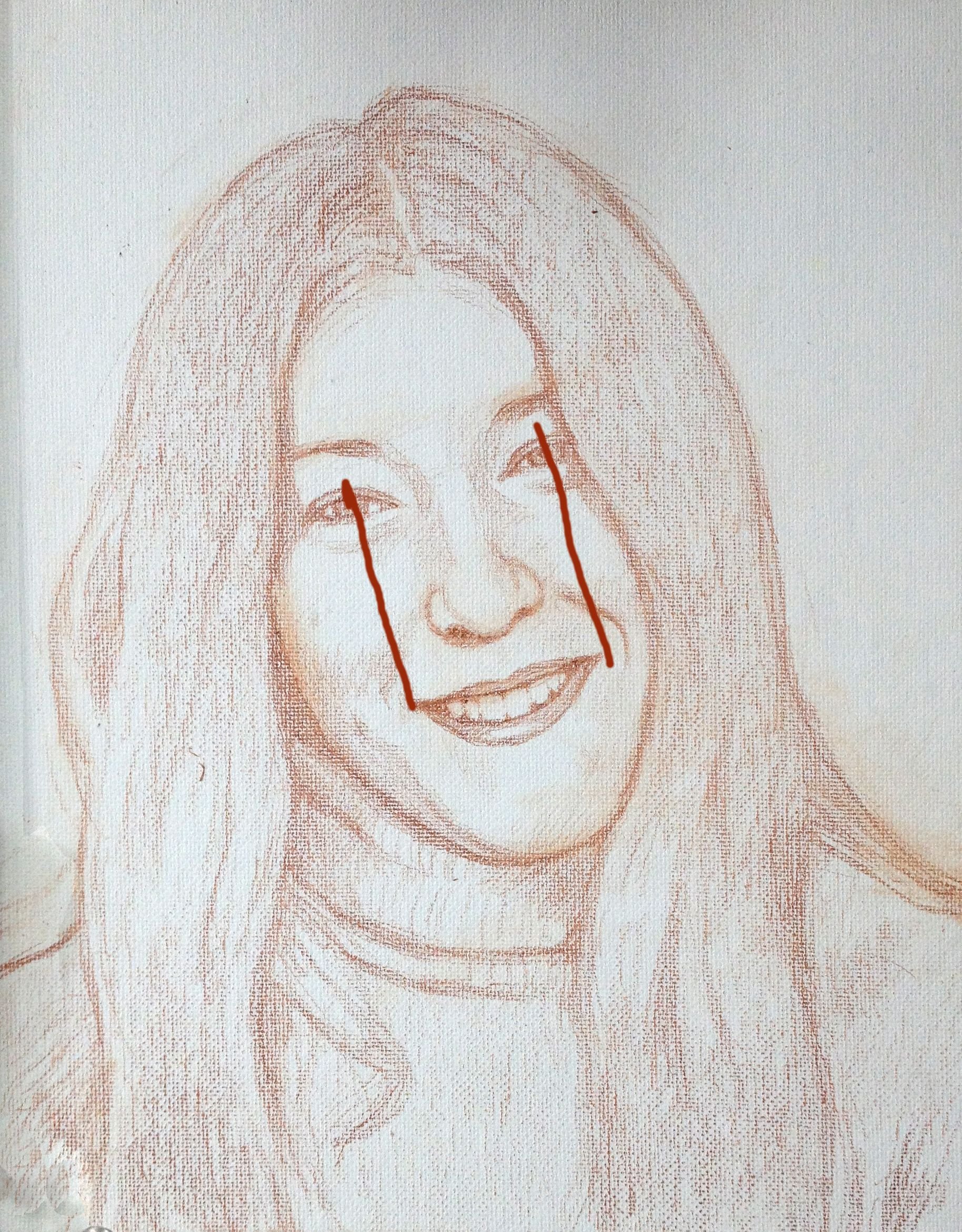
-Don’t draw the teeth in too prominently. Just suggest them. Remember that the two front teeth are larger than the rest. -The bottom teeth, if showing, are slightly more than 1/2 the width of the top.
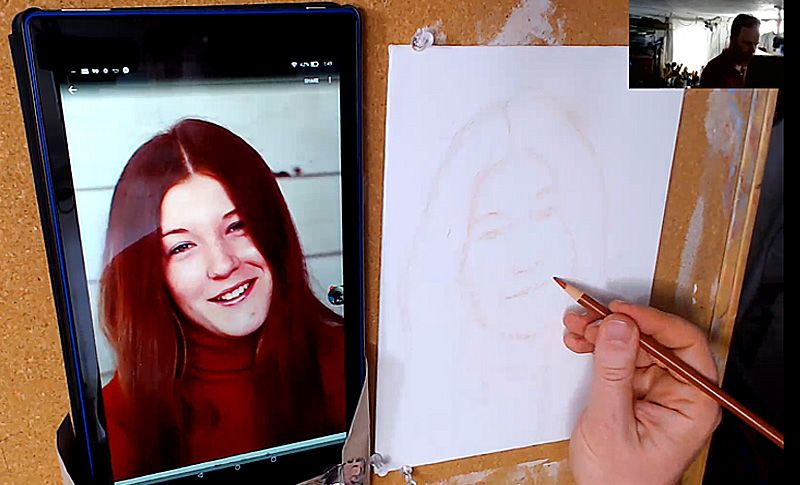
Step 3: Redefining the Facial Features
In this step, you will want to go over everything–the eyes, nose, and mouth: making sure your shapes are accurate. The overall size and proportions should be mostly locked in by this point. So what you’ll want to do is make sure the shapes on all the features match what you see in your reference photo.
Continue to ask yourself some of the questions in the previous step as you refine. And look at your reference photo 50% of the time to make sure you’re drawing what you see, instead of what you think you see!
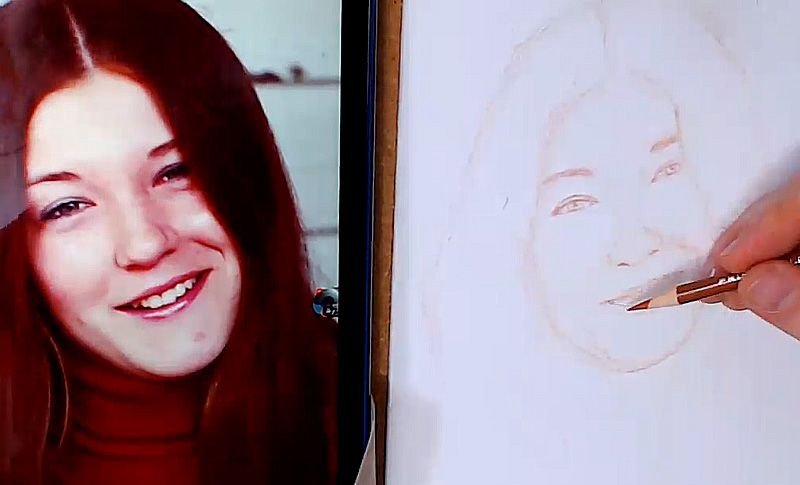
Step 4: Shading in
Maybe it seems redundant to shade in during a sketch, but I find it very helpful. We don’t see any resting objects in this three dimensional world as separated by line.
No.
It’s the contrast between value and color that tells us where an object begins or ends.
So, line is great for plotting composition and initial shape of features, but it is not useful for actually conveying a three-dimensional form on a two dimensional surface.
Which is why I like to shade in my sketches.
Shading will tell you how puffy a cheek is for example. Or how much a nose protrudes outward. Or how small a chin may be. And if you can capture that in the sketch stage (without too much fuss) it will really help you in the painting stage.
The heavy lifting will be done for you. All you’ll have to do in the painting stage is darken those shadows and add more nuances to tie them together. And of course, add color information!
I use the side of my pencil to block in the shadows in large areas. For smaller areas, I’ll use the tip of the pencil.
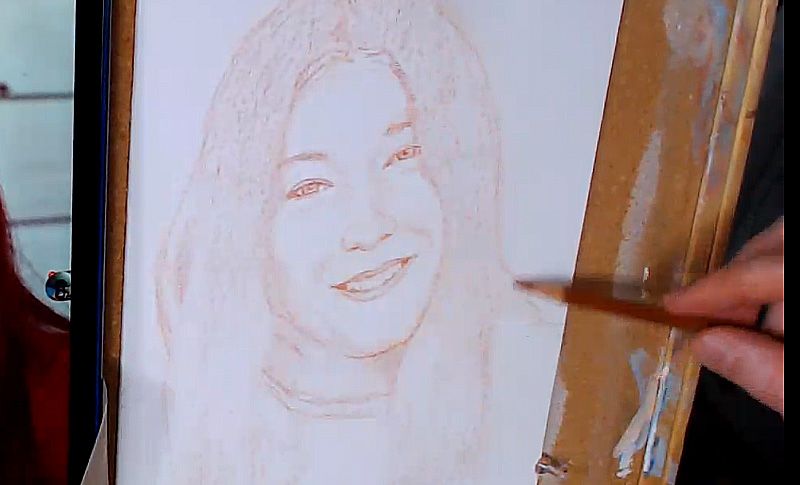
Step 5: Final Touches
The portrait sketch should be looking almost done at this point. Basically, you just want to go over everything, and make sure all minute proportions and shapes are accurate. The BIG proportions should be dialed in by now.
This step should take just a few minutes.
Keep in mind, you won’t get the sketch perfect. There may be a few areas that are getting hard to erase because you’ve drawn over the area so many times.
That’s OK.
Many small mistakes can be corrected in the painting stage. As long as you have everything close, you’ll be fine.
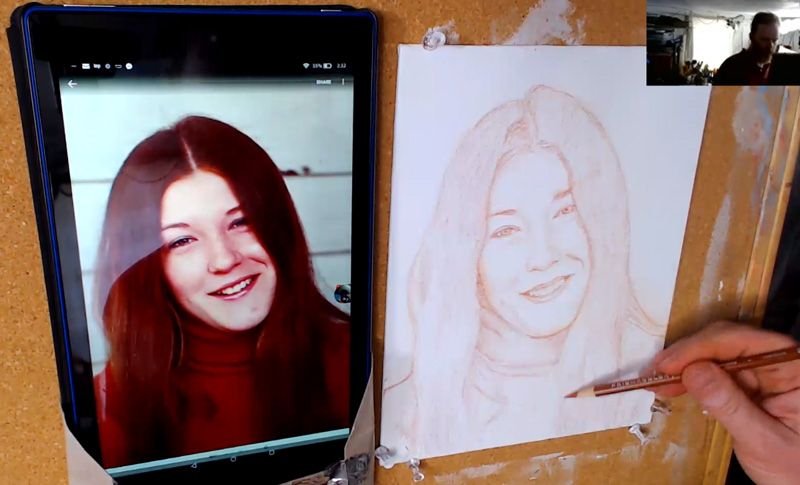
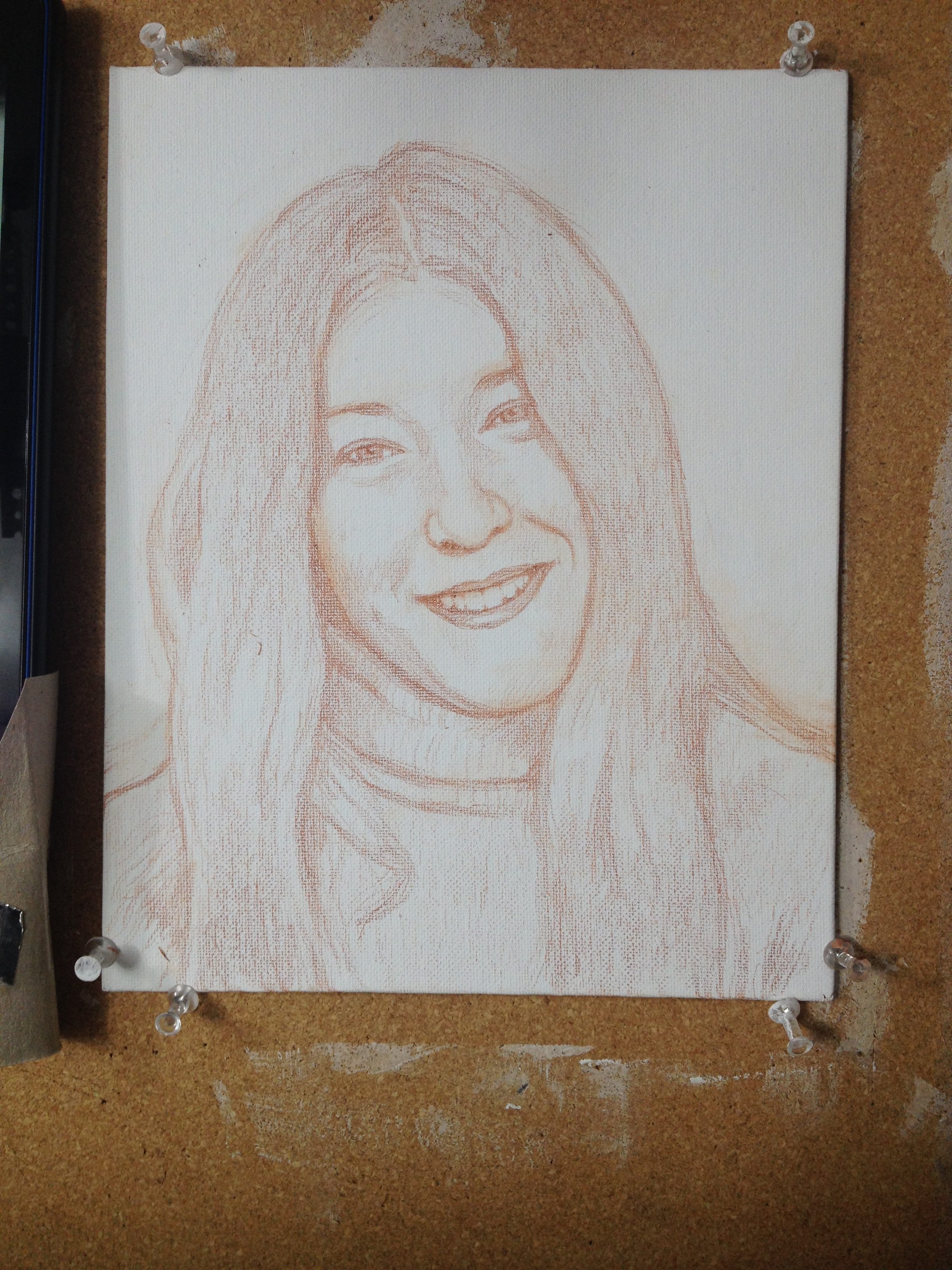
Once the drawing is done, you can step back and look at it from a distance just to make sure you have the likeness captured close enough. If so, you will have a good foundation to begin your portrait.
Have a blessed day,

P.S. Did you find this post helpful or encouraging? If so, send it on ahead! Let others know with the share buttons below. I’d love to hear your comments. Thank you so much! Also, do you have a question on acrylic portrait painting you’d like answered? Let me know, and I’d be happy to help!
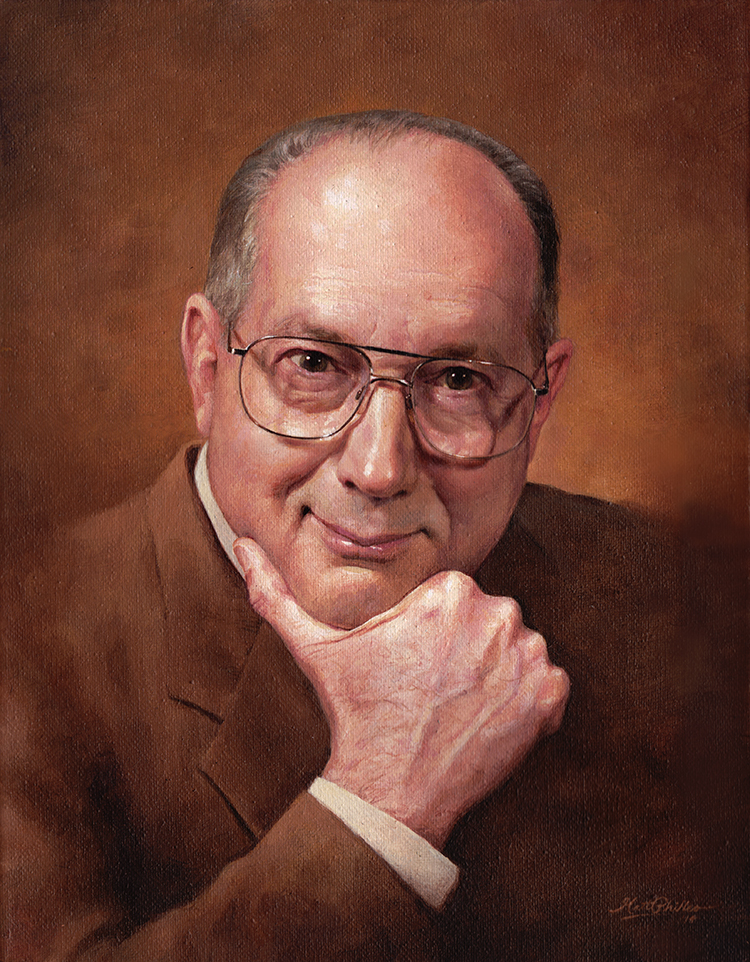
My New Course–“Paint Realistic Wrinkles in Acrylic”
Everyone has at least a few wrinkles.
And so as portrait artists, we need to learn how to paint them–whether we’re painting someone old or young. Painting wrinkles well can really help to capture a person’s likeness in a portrait. They can add so much to the personality.
But it’s not easy. There’s so much to it: the shape, the coloring of the shadows, the highlights, and the blending. How do you do it, without it looking fake?
Do You Struggle To…
- paint wrinkles that look like they are actually wrinkles?
- paint the creases from nose to mouth convincingly, to make it look the person is really smiling?
- show the expression and personality of the person by painting the wrinkles in the forehead correctly?
- paint the different nuances in light and shade, the shadows on the wrinkles and how to make them look natural?
- choose, mix and blend the colors to create realistic shadows and skin tone?
- accentuate the wrinkles without making them too prominent?
- create smooth gradients on your wrinkles, with correct shadows and highlights blending together, cohesively?
- see the correct shape of the wrinkles from your reference photo and accurately represent that on your canvas?
- capture the likeness of the person you’re painting by painting wrinkles realistically?
If you’re an an acrylic portrait painter who struggles with painting wrinkles, then I’d love to help you get better at it.
Introducing My New Course…
“Paint Realistic Wrinkles in Acrylic”
Why did I decide to do a course on painting wrinkles?
I’ve been painting portraits in acrylic for nearly 25 years and teaching classes for the last two. During that time, I’ve taught over 100 students how to paint an acrylic portrait, step-by-step. That course covers a lot of material and it’s been wonderful to see students take it and get noticeably better at their portrait painting.
But one of my students was really struggling with how to paint wrinkles. So I thought, “Why not teach an online class on it?” After getting feedback from my other students, I realized there are other artists who struggle with this as well.
And so, now I’m excited to teach you, too, how to paint wrinkles realistically!
What will we cover in the course?
- Why painting wrinkles well is important and how it can make your paintings better
- The 5 different kinds of wrinkles in the face and how to see them accurately, so you can paint them accurately
- How to sketch wrinkles accurately, and do the “heavy lifting” here so the painting part is way easier.
- Choosing the right colors, mixing and blending so they don’t get muddy.
- Achieving accurate values for both the colors and highlights so the wrinkles actually have depth to them
- Finishing up with a gentle touch, painting smooth gradients, resulting in a portrait that just begs to be looked at
- And more!
Here’s How We’ll Do it
> This is a brand new course, so I will teach a lesson every week, recorded in my studio on Tuesday and released Wednesday morning for the next four weeks. I will upload them to this site, and you will get instant access as soon as they are up. The lessons will start June 6th.
> Each lesson will be about an hour long, and broken up into smaller segments so you can easily watch them and come back to them when you like.
> I’ll respond to your feedback and questions, making sure I’m teaching exactly what you need to succeed.
> You will have lifetime access to these videos on this site (as long as technology holds out) and can watch them at your own pace 24/7.
Enroll Today!
Personal Critiques to Help You When You Feel Stuck
If you need extra help, I’d be happy to record a personal video just for you and critique your work. I’ll point out any areas that could be corrected or refined. I’ll show you exactly with my Crystal Clear Critique method of drawing on top of your reference photo and your portrait in progress, while explaining how to improve an area you’re struggling with. You’ll know exactly what to do to get your sketch or painting back on track.
Getting a Critique is Easy & Effective:
Step 1: In the critique, you email me ([email protected]) a photo of your work in progress, and the reference photo(s) you’re working with, along with your comments on what you’d like addressed or any frustrations you have.
Step 2: I’ll set your portrait up on my video screen and set up the recording.
Step 3: Then I compare and contrast your painting with the reference photo, literally showing you gently (but clearly) what’s working and what could use improvement. This is all on a private, personalized video, not in a group setting. So you never have to feel awkward as if anyone else is judging your work!
Step 4: I send the recorded video back to you (usually within 24 hours or less), where you can access it online via a personalized link, just for you. The critique will typically be about 15 minutes long.
Step 5: You take whatever suggestions you like from my critique, and incorporate them into the painting. Your painting looks great. You feel great about it. You finish the sign the painting and hang it up, send it to the client, or give it to that loved one!
Will it Work?
You might be thinking, “Matt, I know you can teach this stuff, but will this course work for me?” I want to ensure you that it will: if you watch the lessons, put them into practice, and ask me any questions if you aren’t sure about something.
I can’t promise you’ll paint a portrait like Rembrandt. That’s just not a realistic goal starting out. But I can guarantee that your portraits, and more specifically, your ability to paint wrinkles WILL improve as a result of taking this course.
Here’s just a small sampling of comments I receive from my students. It makes my day!
“Wow! This class is one of the most amazing classes I have ever attended. I really felt like I was present in the classroom. You have taught each and every important part of gridding so well. And your lively talks kept us all smiling all the time. Thanks a lot for the excellent advices.”
–Aastha Thakur
“Just a quick thank you for your help. I had written down the colors that you used for your glazing technique on portraits and I can’t believe how much easier it is for me now. I have been dreading this portrait that I volunteered for since last year… I was using too opaque of colors and it caused me to be nervous to lay down any paint in fear that I would make a mistake. The glazing technique is more forgiving and it was like it flowed off my paintbrush. I’ve had blending gel but never really used it so now I’m going to buy stock in it. LOL. I can say that this portrait I’ve done is my best and I have an emotional bond with it because of the circumstances.”
–Keri Sparenga
–Kelly Dywer
Enroll Today!
I feel so blessed that I can paint and teach portrait painting for a living, and to hear back from my students is extra special to me. These are the kinds of results that most of my students are experiencing, not just a select few. Now, just in case you’re still wanting a little extra assurance, I get you. I want to take away all your risk by promising you a bold satisfaction guarantee…
My Win-Win 30-Day Satisfaction Guarantee
Try the course for 30 days. Get some quick wins by trying out a few of the techniques. And if for some reason, you don’t see either the value of what I’m teaching or don’t feel like you’re getting the results you wanted, just email me and let me know. I will gladly refund your entire enrollment fee back, no questions asked.
However…
I only ask one thing: that you watch the lessons. Why? Because I know if you do, and utilize the techniques I teach you, they will work. If you are patient with yourself and consistently practice what you learn, you will see improvement.
Here’s how it will be a win for both of us: If you go through the course, and put the techniques to use, you’ll be able to paint a realistic portrait you can be proud of. And it will be a win for me, because I’ll be happy to see the amazing paintings you create. I’ll let other potential students know they can do it too–which will most likely increase enrollments in the class.
I will do everything I can to help you learn how to paint realistic wrinkles in acrylic. That’s my promise to you.
Imagine what it would feel like to finally paint a portrait that looks real…
…and looks like the person.
A portrait you can be proud to hang on your wall or give as a high quality, unique gift.
Enroll Today!
Let me know if you have any questions, and I look forward to teaching you within the course!
All the best,
P.S. Because of different time zones and schedules of potential students all over the world, we will not be doing live classes. But you will get immediate access to the lessons, after I upload them weekly on Wednesdays, starting June 6.
Enroll today. See you inside the course!
Enroll Today!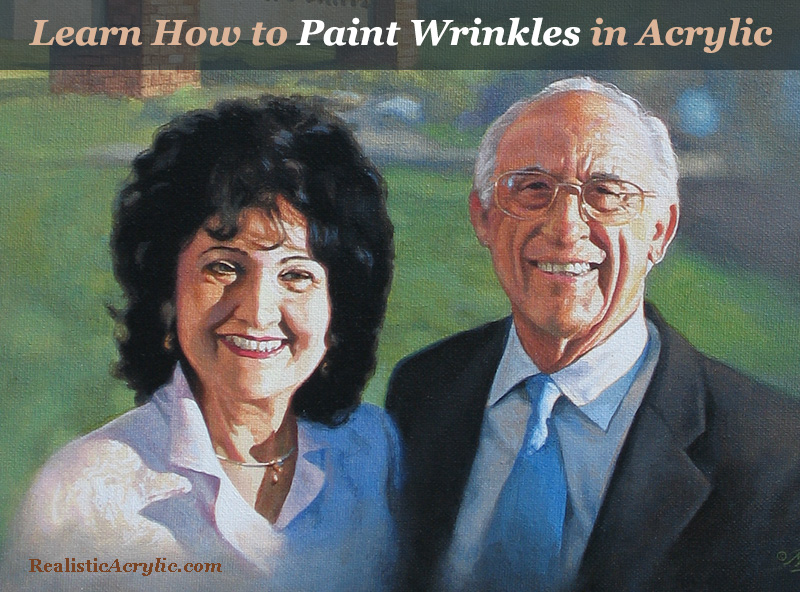
Learn How to Paint Wrinkles in Acrylic
There’s nothing quite as difficult as painting wrinkles. There’s so many details and shapes to get right, and how do you shade them in? That’s what I want to answer in today’s post.
The topic of wrinkles has come up a few times since I started teaching portrait painting two years ago, and most recently when a student asked me how to do it. I shared briefly the steps how in my previous article, “7 Questions About Portrait Painting, Answered.”
Now I want to dive a little deeper.
For an example, I’m going to use one of my favorite paintings–a portrait I did for my pastor, Philip Palser, of Bethel Church in Eau Claire, Wis., to commemorate his 80th birthday. As I write, he is turning 93 this month!

Portrait of Pastor & Mrs. Philip Palser of Bethel Church, Eau Claire, Wis., 16″ x 20″ acrylic on canvas, by artist Matt Philleo to commemorate Pastor’s 80th birthday.
He actually doesn’t have to many more wrinkles than what he had 13 years ago. But they may have deepened a bit with age, signifying his experience. 🙂 Both he and his wife are in amazing health for their age.
Now back to the topic of painting wrinkles…
I’m going to show you just the portion of when they are older–mostly concentrating just on my pastor’s face, because his wrinkles are more apparent.
Step 1: the Sketch
I started with a sketch outlining the major details–such as the the creases around the mouth and the major wrinkles in the forehead.
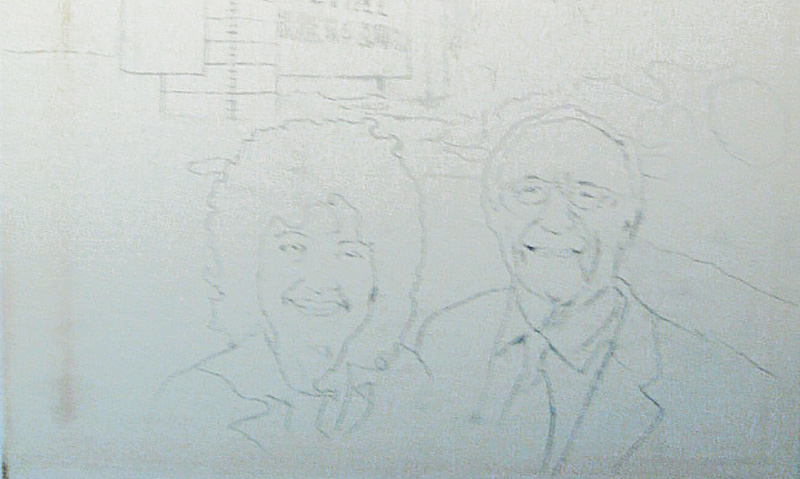
Step 2: Blocking in the Values
Next, I filled in the major values, without a lot of fuss. It is important to accurately define the shapes of the predominant shadows, and put them in their place. They need to stay within their pre-defined boundaries, which ideally would be outlined in the sketch. Now, of course strong lighting–in this case, from the sun–makes this a lot easier.
You may not always have control over this in your portraits, especially if you’re doing a commissioned portrait painting from a photo. But if you can, choose a photo that has strong lighting with a lot of contrast. It really helps model the face, emphasizing its three dimensional form.
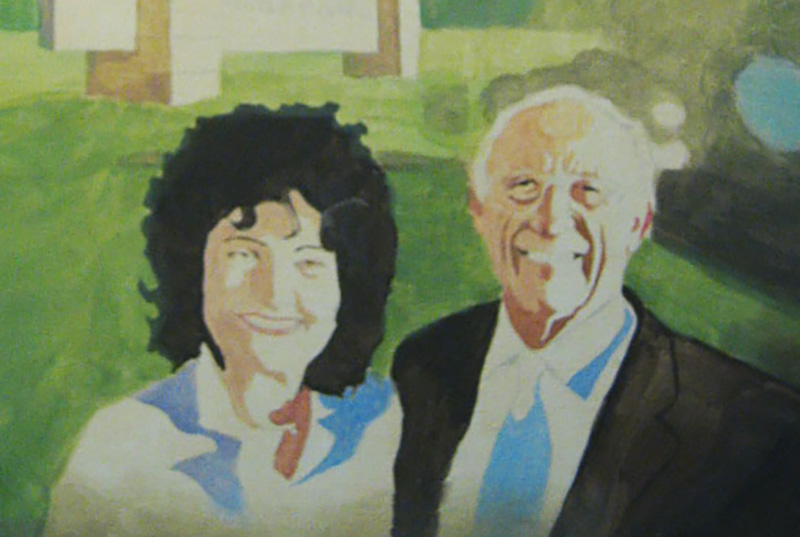
Step 3: Strengthening the Shadows
In this step, I am taking what I did in the previous step and darkening everything. I use burnt sienna and raw umber dark to strengthen the contrast. The vertical wrinkles especially in the man’s forehead and the horizontal crows-feet wrinkles by his eyes are more apparent now. But they are still pretty basic. I did paint in just a slight gradation on the wrinkles that run from the nose to the mouth. But it’s still pretty simple.
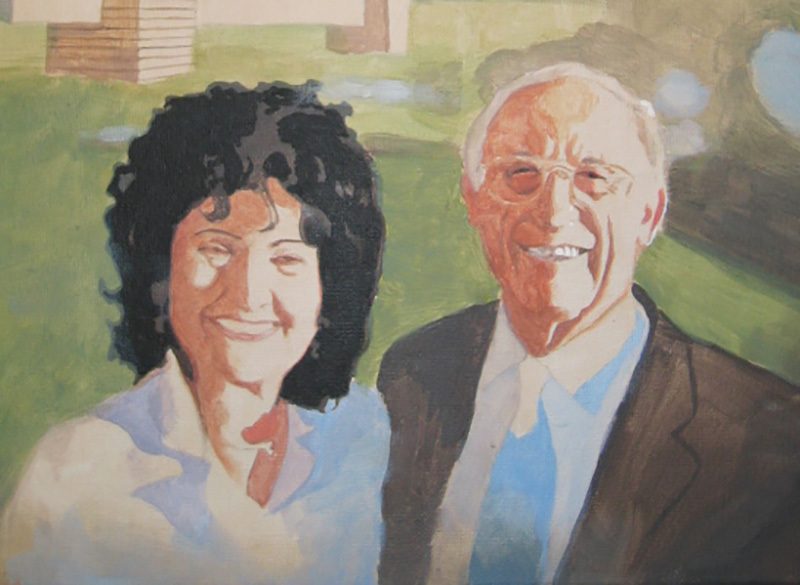
To explain, I broke down the shadows into three categories: the main shadow value, the secondary shadow value, and then the transitional value. These are terms I’ve made up just to differentiate between everything. If you keep things simple to begin with and build on a firm foundation, you will find it a lot easier to achieve the realism you’re shooting for.
It makes me think of a verse where Jesus says, “Anyone who listens to my teaching and follows it is wise, like a person who builds a house on solid rock.” (Matthew 7:24)
If you can teach yourself to see these abstract shapes within your reference photo, and then replicate them on your canvas, you will experience amazing growth in your skills as a portrait painter.
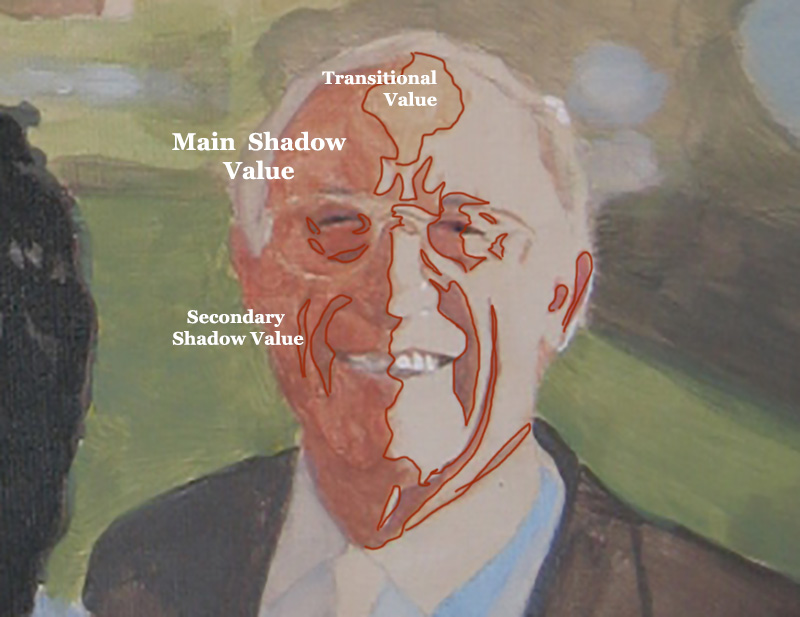
After getting these values locked in, the trick is to bridge them together with some shading and gradation. Notice the highlighted part of his face is flat.
That is OK.
Later, I’ll paint more depth in that area, but for now, it’s not necessary.
Would you like to learn more about how to paint wrinkles? If so, let me know by clicking the button below, and I’ll create a video tutorial/ course for you!
Step 4: Bridging the Gaps
Although I try to give these stages precise beginnings and endings, I don’t want you to think that I am only “bridging the gaps”–transitioning between values only in this stage. But it is at this time, that I’m concentrating on that the most. You can see I added more detail to the transitional value on his forehead.
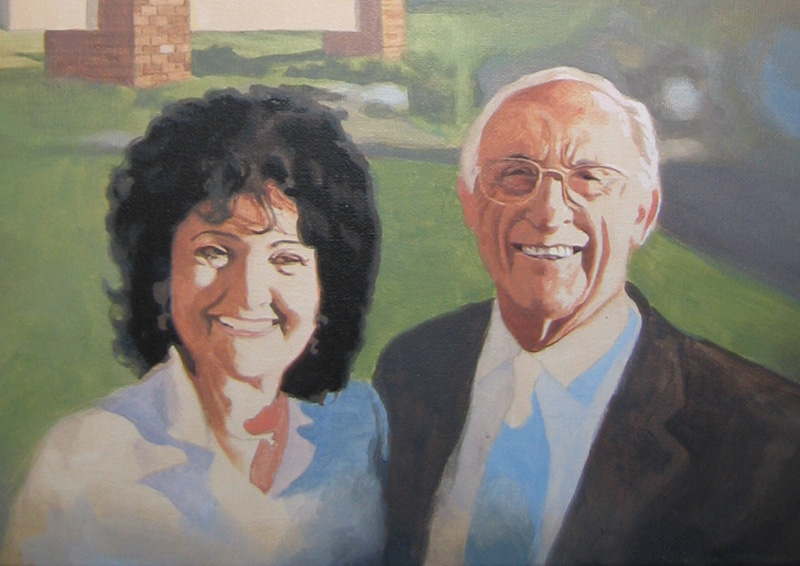
And then, in the image below, you can see how I added more of the secondary value (the same value that’s within the wrinkles on the shadow side) to the vertical wrinkles between his eyebrow ridge and the crease alongside his mouth. Now what that does is add another layer of depth to the wrinkles.
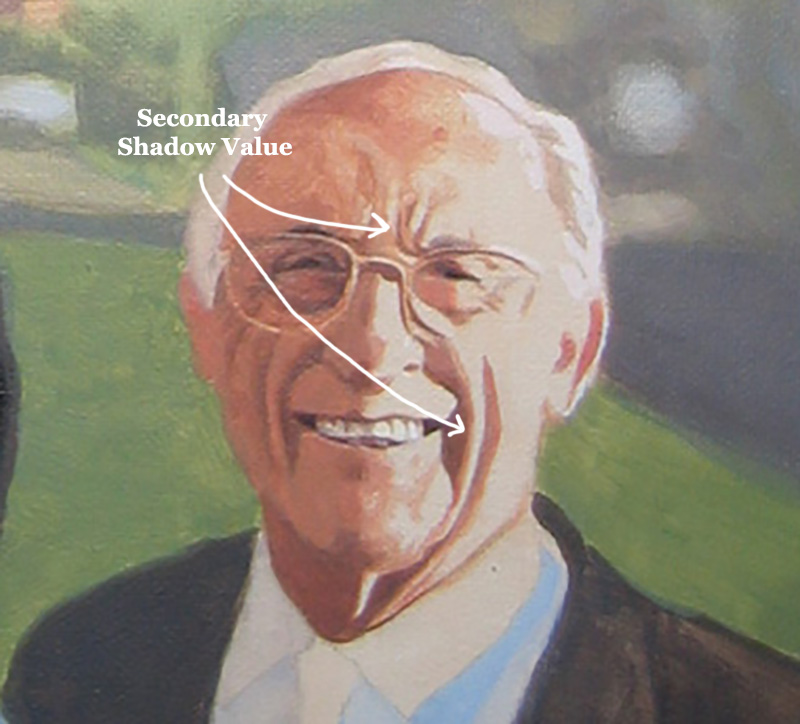
And now also, the underside of the wrinkles look like they’re catching some light from the highlighted part of the face. And that increases the realism.
Step 5: Smoothing out and Finishing With Detail
In this step, I take what I built in the previous foundation, and embellish it. When you have a good foundation and you bring it far enough along, the structure of the wrinkles can just about stand up on their own. But by adding some more shading, we can really make it look nice–like putting on the trim. 🙂
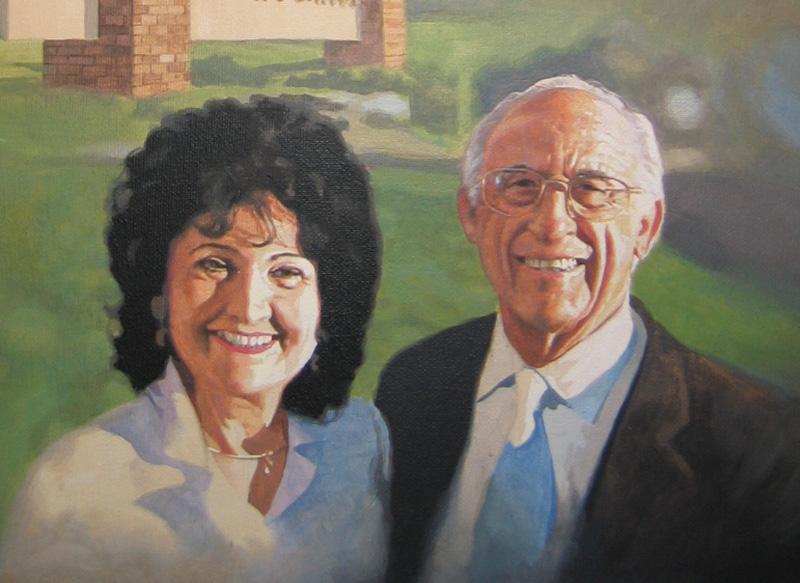
What I did here was add highlights on top of the main highlighted area. This give us one more layer of depth to the face. I put the detail in for the horizontal wrinkles in the forehead as well as some highlights that heightened the creases running alongside the mouth. Some of the thin areas of the forehead wrinkles that you would think would be painted with small round brush were actually created by painting the lighter value and “closing them in.”
However, I would use a small brush to refine them if necessary.
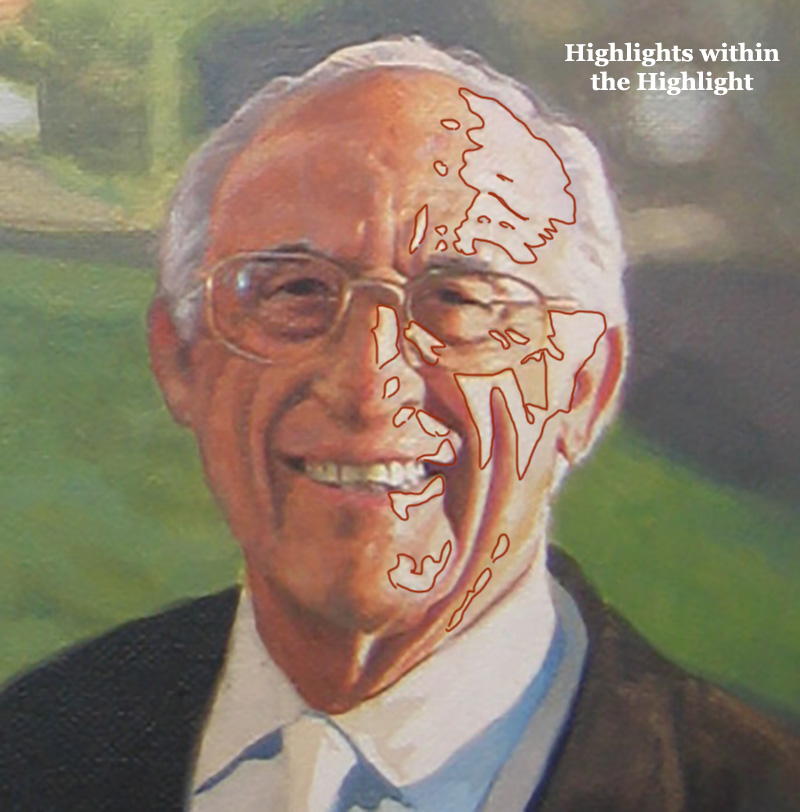
Here is a detail image of the final painting…
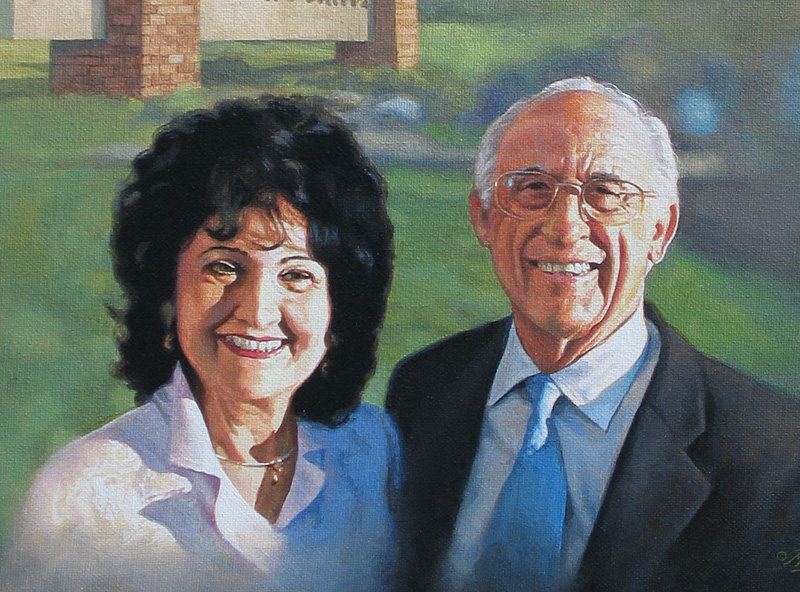
How to Paint Wrinkles in an Acrylic Portrait, with step-by-step tutorial, based off 16″ x 20″ acrylic on canvas portrait by Matt Philleo, final
That’s it for now. Hope you found this tutorial helpful. Let me know if you’re interested in learning more on how to paint realistic wrinkles in acrylic. As I write this, I’m considering doing an online course on the topic. But I need to hear from you first, to see if it’s something you would find interesting and benefit from. Let me know!
Have a blessed day, enjoy painting, enjoy life,

P.S. Did you find this post helpful or encouraging? If so, send it on ahead! Let others know with the share buttons below. I’d love to hear your comments. Thank you so much! Also, do you have a question on acrylic portrait painting you’d like answered? Let me know, and I’d be happy to help!
